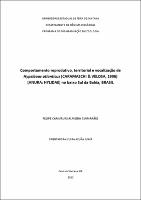| Compartilhamento |


|
Use este identificador para citar ou linkar para este item:
http://tede2.uefs.br:8080/handle/tede/1029| Tipo do documento: | Dissertação |
| Título: | Comportamento reprodutivo, territorial e vocalização de Hypsiboas atlanticus (CARAMASCHI & VELOSA, 1996) (ANURA: HYLIDAE) no baixo Sul da Bahia, BRASIL |
| Autor: | Guimarães, Felipe Camurugi Almeida  |
| Primeiro orientador: | Juncá, Flora Acuña |
| Resumo: | Embora o canto de anúncio seja o mais estudado entre as espécies de anuros, poucos estudos relataram dois cantos de anúncio distintos para a mesma espécie. Hypsiboas atlanticus possui dois tipos de canto de anúncio, emitidos de acordo com o micro-habitat de vocalização (em poleiro ou com o corpo parcialmente na água), além de um canto de encontro e canto de corte. Embora as características dos dois tipos de canto de anúncio permitam uma diferenciação inequívoca, a função destes dois cantos permanece desconhecida. A vocalização e comportamento social dos anuros estão intimamente relacionados à reprodução, portanto, entender a biologia reprodutiva de H. atlanticus, bem como o comportamento social entre machos, poderá sugerir como os dois tipos de canto de anúncio atuam nesta espécie. Este trabalho tem como objetivo verificar como os machos de H. atlanticus utilizam os dois micro-habitats ao longo da noite e como se dá a defesa de territórios nestes micro-habitats, além de estudar a reprodução da espécie, através das características da desova, dimorfismo sexual e acasalamento. Para tanto, uma população de H. atlanticus na Reserva Ecológica da Michelin, município de Igrapiuna, BA, foi estudada durante o período de julho de 2009 a agosto de 2011. A espécie vocalizou durante todos os meses de observação. A temperatura e umidade influenciaram a abundância dos machos na água e no poleiro ao longo da noite. A abundância mensal da espécie não foi relacionada à precipitação. Os machos foram significativamente maiores e mais pesados que as fêmeas e esse dimorfismo parece influenciar o comportamento durante a oviposição. O tamanho dos ovos foi relacionado significativamente com a massa da fêmea. Machos empoleirados apresentaram pouca mudança no canto de anúncio quando estimulados por “playback”, mas responderam com canto de encontro e sinais visuais. Machos na água aumentaram a intensidade ou o número de notas quando estimulados com “playback”. A julgar pelo horário de maior atividade dos machos no poleiro (início da noite) e pelas respostas ao ““playback””, o canto de anúncio no poleiro parece ter maior informação territorial, enquanto que o canto de anúncio na água, local de acasalamento, parece ser o mais atrativo para as fêmeas. |
| Abstract: | Although the ad call is the most studied among anuran species, few studies have reported two distinct ad calls for the same species. Hypsiboas atlanticus has two types of announcement call, issued according to the vocalization micro-habitat (perch or partly in the water), in addition to a meeting corner and cutting corner. Although the characteristics of the two types of ad corner allow for unambiguous differentiation, the function of these two corners remains unknown. The anurans' vocalization and social behavior are closely related to reproduction, therefore, understanding the reproductive biology of H. atlanticus, as well as the social behavior among males, may suggest how the two types of advertisement call act in this species. This work aims to verify how the males of H. atlanticus use the two micro-habitats throughout the night and how to defend territories in these micro-habitats, in addition to studying the reproduction of the species, through the spawning characteristics, sexual dimorphism and mating. Therefore, a population of H. atlanticus in the Michelin Ecological Reserve, municipality of Igrapiuna, BA, was studied during the period from July 2009 to August 2011. The species vocalized during all the months of observation. Temperature and humidity influenced the male abundance in water and perch throughout the night. The monthly abundance of the species was not related to precipitation. Males were significantly larger and heavier than females and this dimorphism seems to influence behavior during oviposition. The size of the eggs was significantly related to the mass of the female. Perched males showed little change in the ad corner when stimulated by “playback”, but responded with meeting corner and visual cues. Males in the water increased the intensity or the number of notes when stimulated with “playback”. Judging by the time of the males' most active activity on the perch (early evening) and the responses to the “playback”, the ad singing on the perch seems to have more territorial information, while the ad singing on the water, mating place , seems to be the most attractive for females. |
| Palavras-chave: | Hylidae Micro-Habitat Comportamento de canto Singing behavior |
| Área(s) do CNPq: | CIENCIAS BIOLOGICAS::ZOOLOGIA CIENCIAS BIOLOGICAS |
| Idioma: | por |
| País: | Brasil |
| Instituição: | Universidade Estadual de Feira de Santana |
| Sigla da instituição: | UEFS |
| Departamento: | DEPARTAMENTO DE CIÊNCIAS BIOLÓGICAS |
| Programa: | Mestrado em Zoologia |
| Citação: | GUIMARÃES, Felipe Camurugi Almeida. Comportamento reprodutivo, territorial e vocalização de Hypsiboas atlanticus (CARAMASCHI & VELOSA, 1996) (ANURA: HYLIDAE) no baixo Sul da Bahia, BRASIL. 2012. 74 f. Dissertação (Mestrado em Zoologia)- Universidade Estadual de Feira de Santana, Feira de Santana, 2012. |
| Tipo de acesso: | Acesso Aberto |
| URI: | http://tede2.uefs.br:8080/handle/tede/1029 |
| Data de defesa: | 10-Fev-2012 |
| Aparece nas coleções: | Coleção UEFS |
Arquivos associados a este item:
| Arquivo | Descrição | Tamanho | Formato | |
|---|---|---|---|---|
| Dissertação_Felipe Camurugi.pdf | Arquivo em texto completo. | 5,76 MB | Adobe PDF |  Baixar/Abrir Pré-Visualizar |
Os itens no repositório estão protegidos por copyright, com todos os direitos reservados, salvo quando é indicado o contrário.




